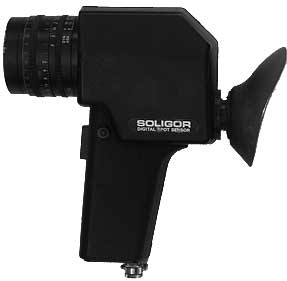
|
  Maker: Soligor Model: Digital Spot Sensor Circa: 1980 Price (new): $309.95 Cell type: Silicon blue Measure type: 1 °Spot Battery: standard 9v |
|
Allied Import & Export (shortened to Allied Impex, or even Alpex) is remembered among photographers for two major things: one is (allegedly) ruining Miranda, and the other is creating a German subsidiary named Soligor, which became their brand for various imported equipment of good-to-excellent accessories.
According to a Modern Photography magazine roundup of meters, this is basically a Soligor Spot Sensor II (which is analog) converted to LED readout. There's an interesting thread on Photo.net where someone claims that the silicon sensor is poorly filtered to block near-infrared, and will thus read high given bright IR light levels. His fix was to change the sensor diode. Personally, I'd try a hot mirror (an Infrared cut filter) first. The story on my particular meter is this: the original owner sold it to someone via eBay. Evidently the package was used to play post-office soccer, and the box arrived with a huge dent and the meter had something rattling around inside it. The seller bought it back, then turned around and sold it again (with damage disclosure) to me. I don't mind buying broken meters if they're cheap (and knowing that it's broken when I buy it). If you want to see what's in it, check out the autopsy. Another note from the internet: If you want this thing professionally repaired or calibrated, check out Richard Ritter. I haven't used him so I have no personal experience either way, but he seems to have a good reputation on the forums. How to use it: this one takes a battery so make sure it's loaded and good. Look through the finder, aim the meter at your target (the circle in the viewfinder shows the area that will actually be measured), and press the red button on the top left side of the handle. You should see an LED readout appear. This is your EV number. To convert the EV number, you can use the calculator dial on the lens barrel of the meter. Set the ASA by using the ring that's closest to the body of the meter. The lower band is ASA, the upper band is DIN. Once you do that, look at the outermost (top) band on the lens barrel. These are the EV numbers. Take the EV number you read in the viewfinder and align it with the white dot. Now you can read the shutter/aperture combinations below. |
|
©opyright by James Ollinger. All Rights Reserved.
Company names and models are registered trademarks of their respective owners
and are not affiliated with this website in any way.

s.jpg)